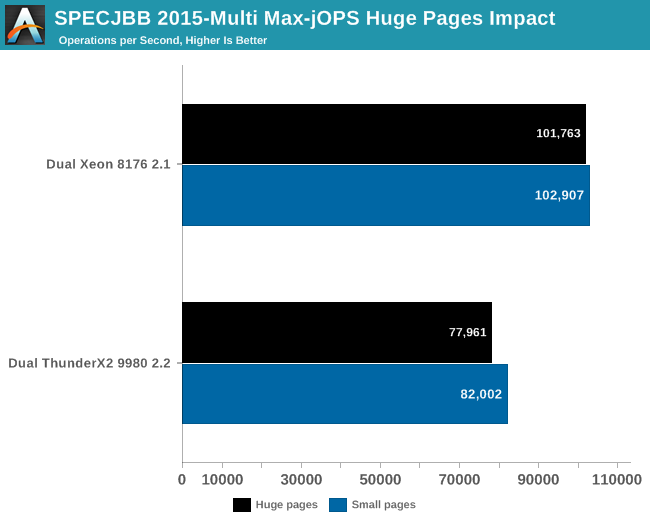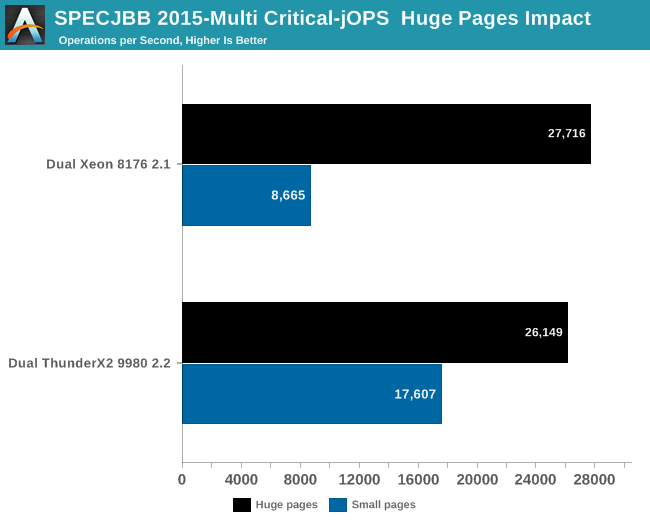Assessing Cavium's ThunderX2: The Arm Server Dream Realized At Last
by Johan De Gelas on May 23, 2018 9:00 AM EST- Posted in
- CPUs
- Arm
- Enterprise
- SoCs
- Enterprise CPUs
- ARMv8
- Cavium
- ThunderX
- ThunderX2
Java Performance: Huge Pages Investigated
Since experience tells us that it is quite rare for one CPU to beat another in a benchmark by a factor 3, we investigated the matter further. The most obvious candidate was Huge Pages, or as everybody besides the Linux community calls it: "Large Pages".
Every modern CPU caches the virtual-to-physical memory mappings in their TLBs. The "normal" size of a page is 4 KB, so with 1536 entries, the Skylake core can only cache about 6 MB per core. Consequently, as DRAM capacity has grown the past 15 years from a few GB to hundreds of GBs, TLB misses have become more and more of a concern. A TLB miss is quite expensive – costing several memory accesses in total – as you need to read out several tables to finally find the physical address.
All modern CPU support larger pages. In the x86-64 (Intel & AMD) a 2 MB large page is the most popular option, while a 1 GB page is also available. Meanwhile a large page on the ThunderX2 is no less than 0.5 GB. Using large pages reduces the number of TLB misses (although the number of entries in the TLB is typically much lower for large pages), and also they reduce the number of memory accesses needed if a TLB miss occurs.
However, it took a while before Linux supported this feature in an easy to handle way. Memory fragmentation, conflicting and hard to configure settings, incompatibilities, and especially very confusing names caused a lot of trouble. In fact, many software vendors still advise server admins to disable large pages. So while it was quickly embraced for benchmarks, the software community as a whole is still hesitant.
To that end, let's see what happens if we enable Transparent Huge Pages and keep the best settings we discussed on the previous page.

Overall, for Max-jOPs the performance impact is nothing spectaculair; in fact it's a slight regression. The Xeon loses about 1% of its throughput, the ThunderX2 about 5%.
Moving on, let's check out the Critical-jOPS metric, where throughput is measured with a 99 percentile response time constraint.

A massive difference! Instead of taking a massive beating, the Intel setup edges out the ThunderX2. Still, it must be said that performance with 4 KB pages seems to be a major weakness with Intel's architecture.










97 Comments
View All Comments
imaheadcase - Sunday, May 27, 2018 - link
Yah i tried that for a bit, it worked ok. But was not foolproof, it missed some stuff.repoman27 - Wednesday, May 23, 2018 - link
Just to provide a counter point, this article made my day. And that’s coming entirely from intellectual curiosity—I don’t plan on deploying any servers with these chips in the near future. I always enjoy Johan’s writing, and was really looking forward to seeing how ThunderX2 would stack up. Many people are convinced that ARM is really only suitable in low power / mobile scenarios, but this is the chip that may finally prove otherwise. That has significant ramifications for the entire industry (including the consumer space), especially when you consider that Cavium could put out a TSMC 10nm or even 7nm shrink of ThunderX2 before Intel can get off of 14nm.HStewart - Wednesday, May 23, 2018 - link
This does not proved that ARM is suitable in higher end space - look at the core specific speed - it extremely low compare to Intel and AMD server chips. Keep in mind it takes 128 total cores - running at 4SMT system. And what about other operations - what about Virtual Machine situation - where you have many virtual x86 machines on VMWare server,How about high end mathematical and vector logic?
It does seem like ARM can run more threads - but maybe Intel or AMD has never had the need to
I think this latest Core battle is silly - I think it really not the number of cores you have but combination of type and speed of cores along with number of cores.
Wilco1 - Wednesday, May 23, 2018 - link
It certainly does prove that Arm can do high end servers - the results clearly show IPC/GHz is very close on SPECINT. Base clock speeds are the same as the Intel cores, and that's the speed the server runs at when not idle. But there are more cores as you say, so who will win is obvious.Now imagine a next-gen 7nm version before Intel manages 10nm. Not a pretty picture, right?
HStewart - Wednesday, May 23, 2018 - link
Ok I have learn to agree to disagree with some peopleCan this server run the VMWare server
https://kb.vmware.com/s/article/1003882
The answer is no - just one example - many more,
On 10nm - it not number that matters - it technology behind it - Intel supposely has a i3 and Y based for CannonLake coming this year - probably more.
Wilco1 - Wednesday, May 23, 2018 - link
There are plenty of VMs for Arm, so virtualization is not an issue.10nm will be behind 7nm even if it ends up as originally promised and not using relaxed rules to become viable for volume production.
ZolaIII - Thursday, May 24, 2018 - link
When optimized for SIMD NEON extension things changed dramatically. All tho NEON isn't exactly the best SIMD never the less number's speak for them self.https://blog.cloudflare.com/neon-is-the-new-black/
Tho Centriq is a bit pricier, bit overly slower than this but main point is it whose built on comparable lithography to current Intel's 14nm. So you get cheaper hardware, which can be packaged tighter & will consume much less power while being compatible regarding the performance. Triple win situation (initial cost, cost of ownership and scaling) but it still isn't turn key one whit isn't crucial for big vendor server farms anyway.
name99 - Thursday, May 24, 2018 - link
ARM (and this particular chip) aren't trying to solve every problem in the world. They're trying to offer a better (cheaper) solution for a PARTICULAR subset of customers.If you think such customers don't exist, then why do you think Intel has such a wide range of Xeons, including eg all those Xeon Silvers that only turbo up to 3GHz? Or Xeon Gold's that max out at 2.8GHz?
lmcd - Thursday, May 24, 2018 - link
Second page: supports SR-IOV, which is important for KVM and Xen. If you're not aware, Xen and KVM are powerful virtualization solutions that cover the feature set of VMWare quite nicely.HStewart - Wednesday, May 23, 2018 - link
"I really think Anandtech needs to branch into different websites. Its very strange and unappealing to certain users to have business/consumer/random reviews/phone info all bunched together."I different in this - I don't think AnandTech should concentrate on just gaming in focus - this is rather old school - I am not sure about mobile phones in the mess of all this
But comparing ARM cpu's to Intel/AMD is interesting subject. It basically RISC vs CISC discussion - yes RISC can do operations quicker in some cases - but by definition of the architecture they are Reduce in what they do. Fox example it would take RISC a ton of instructions to executed a single AVX style operation.
This article is closest I have seen in comparing ARM vs x86 base machines - but even though I see some holes - it comes close - but having just be Linux based leaves out why people purchase such machine - I think Virtual Machine server is huge - but like everything else on the internet that is just an opinion